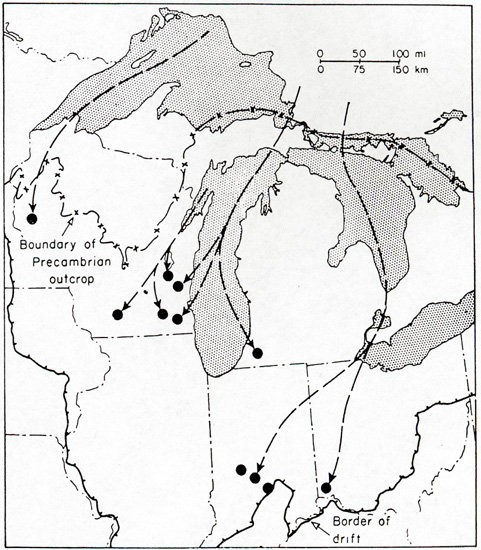DIAMONDS?
Diamonds have been known to occur in the Lake Superior region for well
over a century. Most of the diamond discoveries have been in glacial deposits in
southeastern Wisconsin, mainly in the late 1800s when water wells were dug in the glacial
drift. The map below shows the locations of diamond "finds" in the Great
Lakes region, and the possible paths that they took to get to those locations. The
origins of diamonds in the region can be traced back to the Precambrian
rocks of the Canadian Shield, the southern boundary of
which is also shown on the map below.

Source: Unknown
The first documented diamond discovery in Wisconsin was made during the
digging of a well in 1876 by Charles Wood, in southwestern Waukesha County. The digging
had passed through 10 to 15 m of clay, and then through loose gravel, when a two meter
layer of hard yellow material was struck. While penetrating this stratum, a hard stone of
unknown identity was struck. Clarissa Wood took this peculiar pebble to a jeweler in
Milwaukee, who identified the stone as "topaz," and purchased it for $1.00. Once
the true identity of the diamond was disclosed, Clarissa offered to buy the diamond back,
first for $1.00 and later for $1.50. The jeweler refused, and Mrs. Wood sued. The Supreme
Court ruled that the stone was the property of the jeweler because he believed it was
topaz when he bought it. He later sold the stone to Tiffany’s for $850. The crystal,
originally known as the Waukesha Diamond and later, the Eagle Diamond, is a warm yellow
color and weighs 16.25 carats.
J. P. Morgan, the 19th century financier, purchased the
Eagle diamond from Tiffany’s and ultimately donated the gem to the American Museum of
Natural History in New York City. The stone was on public display at the museum until the
evening of October 29, 1964, when "Murph the Surf" broke in, and departed with
the Eagle Diamond and other gems. The stone has not been recovered.
The stone which created the greatest interest in the possibility of
diamonds in Wisconsin was discovered in 1888 near the Green Lake Moraine and is known as
the Theresa Diamond. The stone weighed 21.5 carats and is the largest diamond on record
ever recovered in the State, and the fifth largest in the United States.
Because these, and the several other diamonds discovered in the Lake
Superior region, have come from glacial deposits, there has been much speculation on the
source of the diamonds. Diamonds are very rare, and originate in distinctive rocks known
as kimberlites. Kimberlites originate deep within the earth’s mantle and are
brought to the surface in violent, gas-charged eruptions. Most kimberlites emerge at the
surface as roughly circular, pipelike bodies generally only 100 feet or less across. The
diamonds, which also originate in the mantle, are carried up to the surface in these small
pipelike bodies.
Considering the combination of the small size of the kimberlite pipes,
and the fact that nearly all of the Lake Superior region is covered with glacial deposits,
it is not surprising that the potential source of the diamonds remained unknown for many
years. In 1970, two geologists engaged in mineral exploration in northern Michigan,
discovered a peculiar rock exposed by a bulldozer on a logging road near Lake Ellen, east
of Crystal Falls, Michigan. The rock was badly weathered, but had a composition suggesting
that it might be a kimberlite. Subsequent tests verified that the rock was indeed a
kimberlite. Thus, nearly 100 years after the first diamonds were found in the Lake
Superior region, a potential source of the diamonds was discovered.
Despite extensive testing on the Lake Ellen Kimberlite, however, no
meaningful diamonds were discovered. Extensive geological studies in northern
Michigan and Wisconsin have resulted in the discovery of more than a dozen kimberlite
bodies, mainly in the area between Crystal Falls and Escanaba. Although some of the
kimberlites contain small quantities of microdiamonds, none of them appear to have
commercial quantities of diamonds. Therefore, the source of the large diamonds found
in the glacial deposits of southeastern Wisconsin remains unknown.
At least four major corporations have had leases from the State of
Michigan to search for diamonds, but have been very secretive about it. Representatives
from South Africa have explored for new diamond fields in the UP and have bought up the
mineral rights to extensive areas there.
It is also believed that there may be a number of valuable stones in
the region, including sapphires and rubies.
This material has been compiled for educational use only, and
may not be reproduced without permission. One copy may be printed for personal
use. Please contact Randall Schaetzl (soils@msu.edu)
for more information or permissions.